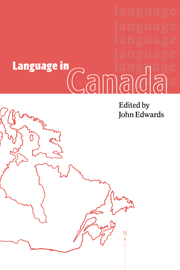Book contents
- Frontmatter
- Contents
- List of figures
- List of maps
- List of tables
- Notes on contributors
- 1 Canada
- Introduction
- 1 The foundations
- 2 The fading Canadian duality
- 3 Official bilingualism: from the 1960s to the 1990s
- 4 Official multiculturalism
- 5 Language in education: bridging educational policy and social psychological research
- 6 Aboriginal languages: history
- 7 Aboriginal languages: current status
- 8 French: Canadian varieties
- 9 French in Quebec
- 10 French in New Brunswick
- 11 French outside New Brunswick and Quebec
- 12 English: Canadian varieties
- 13 English Quebec
- 14 The teaching of international languages
- 15 French immersion in Canada
- 16 Language in Newfoundland
- 17 Language in Prince Edward Island
- 18 Language in Nova Scotia
- 19 Language in New Brunswick
- 20 Language in Quebec: aboriginal and heritage varieties
- 21 Language in Ontario
- 22 Language in Manitoba
- 23 Language in Saskatchewan: Anglo-hegemony maintained
- 24 Language in Alberta: unilingualism in practice
- 25 Language in British Columbia
- 26 Language in the Northwest Territories and the Yukon Territory
- Index of names
- Index of language families, languages, dialects
- Index of subjects
Introduction
Published online by Cambridge University Press: 18 February 2010
- Frontmatter
- Contents
- List of figures
- List of maps
- List of tables
- Notes on contributors
- 1 Canada
- Introduction
- 1 The foundations
- 2 The fading Canadian duality
- 3 Official bilingualism: from the 1960s to the 1990s
- 4 Official multiculturalism
- 5 Language in education: bridging educational policy and social psychological research
- 6 Aboriginal languages: history
- 7 Aboriginal languages: current status
- 8 French: Canadian varieties
- 9 French in Quebec
- 10 French in New Brunswick
- 11 French outside New Brunswick and Quebec
- 12 English: Canadian varieties
- 13 English Quebec
- 14 The teaching of international languages
- 15 French immersion in Canada
- 16 Language in Newfoundland
- 17 Language in Prince Edward Island
- 18 Language in Nova Scotia
- 19 Language in New Brunswick
- 20 Language in Quebec: aboriginal and heritage varieties
- 21 Language in Ontario
- 22 Language in Manitoba
- 23 Language in Saskatchewan: Anglo-hegemony maintained
- 24 Language in Alberta: unilingualism in practice
- 25 Language in British Columbia
- 26 Language in the Northwest Territories and the Yukon Territory
- Index of names
- Index of language families, languages, dialects
- Index of subjects
Summary
Most readers will know that issues of language and culture are central to current Canadian social and political life. Recent constitutional crises have, one regrets to say, made the country – and Quebec in particular – excellent contexts in which to observe languages in contact, minority-group and ethnolinguistic dynamics, the relationship between language and nationalism, and the strains under which officially sponsored policies of ‘social engineering’ (bilingualism and multiculturalism) must now operate. In some settings, disputes over language and culture are largely symbolic; deeper problems between groups lie elsewhere, usually in political or economic domains, and language, or religion, or tradition act mainly as team jerseys. To discuss symbolism, of course, is not to discuss something inconsequential. The power attaching to what people believe best represents their culture can be considerable. Indeed, the intangible strength of ‘blood and belonging’ has made itself all too evident historically. In Canada, it is quite clear that this sort of powerful symbolic marking is at work but, in addition, the force of nationalism is itself central to much of the debate. It is not economic deprivation or lack of effective political representation which most accurately characterizes the Quebec sovereignty movement, for example. It is, rather, what John Stuart Mill referred to more than a century ago:
If … unreconciled nationalities are geographically separate, and especially if their local position is such that there is no natural fitness or convenience in their being under the same government … there is not only an obvious propriety, but, if either freedom or concord is cared for, a necessity, for breaking the connection altogether.
(1964 [1861], pp. 361-366)Information
- Type
- Chapter
- Information
- Language in Canada , pp. 1 - 12Publisher: Cambridge University PressPrint publication year: 1998
